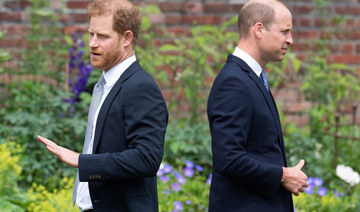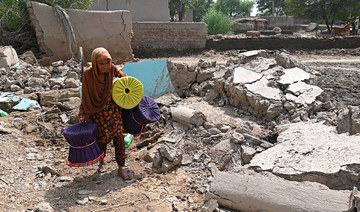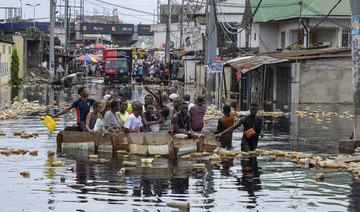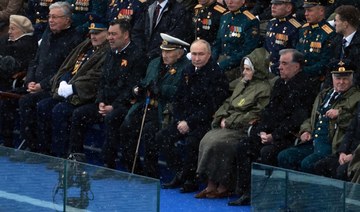LONDON: Prince Harry has accused his stepmother, Camilla, the queen consort, of leaking private conversations to the media to burnish her own reputation as he promotes a new book that lays bare his story of his life behind palace walls.
In interviews broadcast Sunday and Monday, Harry accused members of the royal family of getting “into bed with the devil” to gain favorable tabloid coverage, singling out Camilla’s efforts to rehabilitate her image with the British people after her longtime affair with his father, now King Charles III.
“That made her dangerous because of the connections that she was forging within the British press,” he told CBS. “There was open willingness on both sides to trade information. And with a family built on hierarchy, and with her on the way to being queen consort, there was gonna be people or bodies left in the street.”
Harry spoke to Britain’s ITV, CBS’s “60 Minutes” and “Good Morning America″ to promote his book “Spare,” which is to be widely released Tuesday. Some UK bookshops plan to open at midnight to meet demand for the highly anticipated memoir, which has generated incendiary headlines with reports that it includes details of bitter family resentments, as well as Harry and his wife Meghan’s decision to give up their royal roles and move to California.
In the interviews, Harry repeatedly blamed the media for the troubles that afflicted the couple, also known as the Duke and Duchess of Sussex, saying the coverage contributed to the rift with his brother, Prince William, and his wife, Kate.
“They always pitched us against each other,″ he told Good Morning America. “They pitch Kate and Meghan against each other.”
Harry was also unapologetic about launching legal battles against some parts of the British media. While he said his father believes it is “probably a suicide mission” to take on the press, Harry described changing the media landscape in the UK as being “my life’s work.”
But Harry also continued to criticize the royal family itself.
He repeated his claim that there was “concern” in the royal family about his unborn child’s skin color after he married biracial American actress Meghan Markle. Harry and Meghan first mentioned the incident during an interview with Oprah Winfrey in 2021, but they haven’t identified the family member who expressed concern.
Harry insisted his family wasn’t racist, but said the episode was an example of unconscious bias. The prince told CBS that he was “probably bigoted” before he met Meghan, and said that the royal family, which is held to a higher moral standard, needed to “learn and grow” in order to be “part of the solution rather than part of the problem.”
“Otherwise unconscious bias then moves into the category of racism,” Harry told ITV.
“Spare” explores Harry’s grief over the death of his mother in 1997, and his long-simmering resentment at his role as the royal “spare,” overshadowed by the “heir” — older brother William. He recounts arguments and a physical altercation with William, reveals how he lost his virginity and describes using cocaine and cannabis.
He also says he killed 25 Taliban fighters while serving as an Apache helicopter pilot in Afghanistan — drawing criticism from both the Taliban and British military veterans.
The allegations about Camilla are particularly sensitive because of her role in the acrimonious breakdown of Charles’ marriage to the late Princess Diana, William and Harry’s mother.
Diana once described Camilla, who carried out a long-term affair with Charles, as the third person in their marriage. While many members of the public initially shunned Camilla, she has won fans by taking on a wide range of charitable activities and has been credited with helping Charles appear less stuffy and more in tune with modern Britain.
Writing about his father’s 2005 wedding to Camilla, Harry says: “I had complex feelings about gaining a stepparent who, I believed, had recently sacrificed me on her personal PR altar.” Still, he says he wanted his father to be happy. “In a funny way I even wanted Camilla to be happy. Maybe she’d be less dangerous if she was happy?”
“Spare” is the latest in a string of public pronouncements by Harry and Meghan since they quit royal life and moved to California in 2020, citing what they saw as the media’s racist treatment of Meghan and a lack of support from the palace. It follows the interview with Winfrey and a six-part Netflix series released last month.
In the ghostwritten memoir, Harry, 38, describes the couple’s acrimonious split from the royal family after their request for a part-time royal role was rejected.
The television interviews are certain to pile more pressure on the royal family. Harry is also appearing on “The Late Show with Stephen Colbert.”
Royal officials haven’t commented on any of the allegations, though allies have pushed back on the claims, largely anonymously.
Harry has defended the memoir describing it as his effort to “own my story” after years of “spin and distortion” by others. In the “60 Minutes” interview, Harry denied his book was intended to hurt his family.
Omid Scobie, co-author of “Finding Freedom,” a book on the Duke and Duchess of Sussex, said Harry is offering the look behind the palace walls that the public has always wanted.
“Of course, that does come with some downsides for those who have been part of his journey,″ Scobie told the BBC. “We heard some sort of really startling confessions and stories about members of the royal family, particularly when it comes to Camilla and her relationship with the press.’’
While Harry said he hadn’t spoken with his father or brother in a while, he hopes to find peace with them. But he told ITV that the “the ball is in their court.”
“They’ve shown absolutely no willingness to reconcile,” he said.
While the saga is damaging to the royal family, it may not be as harmful as people might think and will give the global audience a forum to discuss difficult issues like misogyny and racism, said Boston University professor Arianne Chernock, an expert in modern British history.
But she was cautious about doomsayers suggesting the monarchy itself was in trouble. The institution has endured more than 1,000 years after all.
“This is a central component of the history of the royal family,’’ she said. “Scandal is the norm not the exception.’’


























